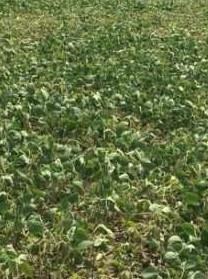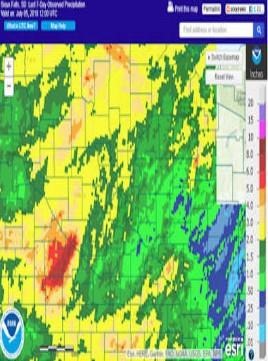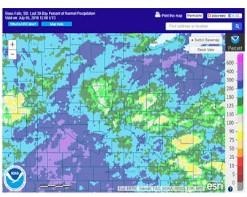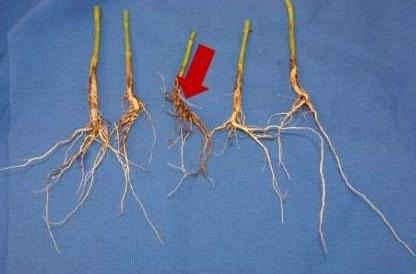By Anne E. Dorrance
Background
I received many calls last week from areas south of and along Interstate 70 that received more than 3 inches of rain and I expect next week they will come from northern Ohio where 4 or more inches of rain landed in some or our plots.
Flooding Injury

Flooding injury can range from lower roots killed to the whole plants if submerged for a long enough period of time. The damage and the yield loss associated with flooding injury are directly related to the amount of time the plants are in a low soil oxygen or high carbon dioxide state. The longer the time, the more damage. Most of the plants that I observed and collected last week will recover and in fact many had new roots coming at the top of the root, near the soil line. Most of the nodules were killed, and had turned gray and soft, but on some plants, the nodules at the top were still pink to red when you split them open. The common and tell-tale symptom of flooding injury are the white rat-tail appearance of the roots. The outer root tissue, the cortical layer, can easily be pulled off the roots and leaves the white, woody-feeling, center of the root. The plants will be yellow for a short time while they are recovering, but they will catch up. It is still early enough of a growth stage in soybean that the neighbors that survive will compensate for any plants that were killed either from other root pathogens or just killed out right from the flooding.

Phytophthora
Root rots and Phytophthora turn roots brown to black. These flooded soil conditions are just what the water molds need to infect soybean. When the fields are saturated these water molds form fruiting structures that have zoospores that swim through the soil water to the roots. These root pathogens produce all kinds of enzymes that break down the cell walls, the plants can fight back but the end result are soft brown roots. If the plants have resistance to these pathogens, they will also develop new roots and continue to grow – but there is a yield hit for severe damage.

If plants have low levels of partial resistance to Phytophthora, then the stem rot phase will develop following infection. The plants will turn yellow and a brown canker will develop on the stems. The Rps genes (1c, 1k, 3a, and 6) will give some protection to some of the strains of Phytophthora in these fields, but not to all. We can identify more than 50 different strains of Phytophthora from a single field. For Ohio, Rps1c has not been effective to more than half of the strains since the mid-1980s and Rps1k and Rps3a since the early 2000s.

In Ohio, we are very dependent on the partial resistance, (also called tolerance in the seed industry) portion of the package. Both the Rps genes and partial resistance will hold up under flooding stress. In fact, we recently identified one locus that has both partial resistance and flooding tolerance with our collaborators at University of Missouri. If you see a lot of plants develop Phytophthora stem rot in your field – you know two things. The first is that the Phytophthora package for that field is not right. For Ohio farmers, check the partial resistance score, a range of 1 to 9. Don’t forget to read the fine print at the bottom of the table to see if it is a 1 to 9 where 9 is good and 1 is poor or vice versa? Then check the variety rating. If the plants have Rps1c or Rps1k and they develop stem rot – then you will also know that that these Rps genes are not doing the job. Look at the proportion of plants – is it a few plants here and there or every plant has stem rot. For fields with a lot of stem rot – focus on the best partial resistance score and add a gene stack with more than one Rps gene.
Soybean Field Problem | Characteristics |
Phytophthora stem rot, Phytophthora sojae | - Soybeans dying during early vegetative growth stages. The tissue is dried, brown, and collapsed.
- Phytophthora stem rot on plants with very low levels of partial resistance. Note the characteristic chocolate brown canker going up the stem. The Internal tissue is also brown and decayed.
|
| Flooding Injury | - Large numbers of plants in low lying areas of field
- Wilted appearance, some yellowing of leaves
- Almost a shepherds hook appearance on the tops
- New leaves on mildly affected plants were growing
- Note grayish color on some of the older leaves.
Figure 5. These are the roots from plants collected in the flooded areas of fields Note the “rat-tail” appearance of the roots the outer cortical tissue of the roots was killed during the flooding and can be easily pulled off the roots. What is left is woody and tough. Also note on these roots that there are new roots forming at the tops of each of these roots. The nodules are missing or dead from the flooding, but new ones will form. If this was Pythium or Phytophthora- the roots would be soft and brown |